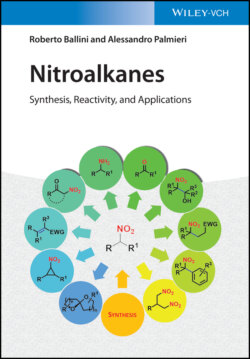Читать книгу Nitroalkanes - Roberto Ballini - Страница 21
1.4.1 Reduction of Nitroalkenes into Nitroalkanes
ОглавлениеThe reduction of conjugate nitroalkenes into nitroalkanes (Scheme 1.16) has been achieved under several distinct protocols; however, often there is a loss of product due to dimerization caused by the competitive Michael addition of the formed nitronate to another molecule of nitroalkene.
Scheme 1.16 Reduction of nitroalkenes.
However, because this by-product may be suppressed at reduced pH, the main theme of several reports is the selective reduction of the double bond avoiding the formation of the Michael by-product. Thus, a plethora of reductive methods have been reported. A modified reduction with sodium borohydride in the presence of both silica gel and a mixture of chloroform-propanol as solvent system achieves good results of nitroalkanes (Table 1.1) [29].
Successively, Kabalka et al. [28] proposed three different reductive agents (Table 1.2): (i) trialkylborohydride, (ii) NaBH4 in a mixed MeOH-THF solvents, and (iii) NaBH4 supported on an ion exchange resin, for an effective conversion of nitroalkenes to nitroalkanes.
Table 1.1 NaBH4/SiO2 reduction of nitroalkenes (selected examples).
| Nitroalkene | Nitroalkane | Yield (%) |
|---|---|---|
| 93 | ||
| 92 | ||
| 94 | ||
| 94 | ||
| 98 |
Table 1.2 Comparative reduction of nitroalkenes with methods (i)–(iii) (selected examples).
| Nitroalkene | Nitroalkane | Yield (%) | ||
|---|---|---|---|---|
| (i) | (ii) | (iii) | ||
| 69 | 62 | 80 | ||
| 78 | 64 | — | ||
| 81 | 82 | 80 | ||
| 69 | 75 | 83 |
Later, Vankar and coworkers [30] developed an efficient, chemoselective procedure for the reduction of conjugated nitroalkenes with the use of NaCNBH3 (1 equiv) in methanol (Table 1.3), by the help of Zeolite (H-ZSM-5, [Si:Al = 35 : 1], 0.5 equiv), and a careful control of the pH.
